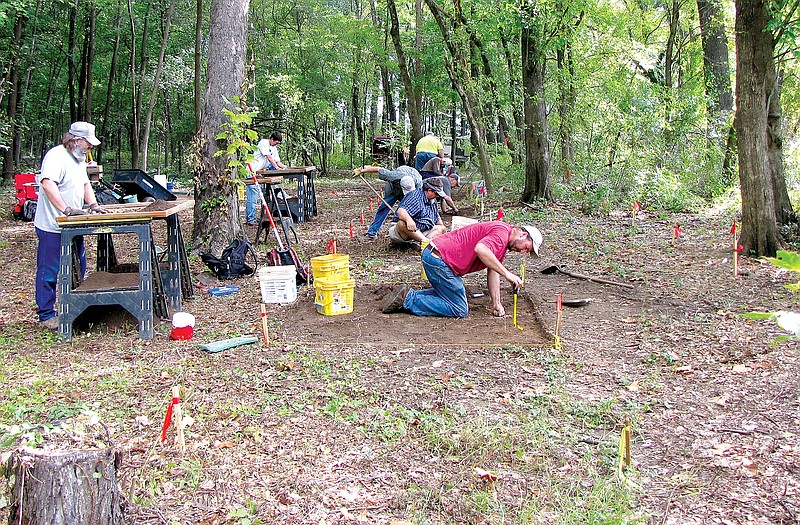"People kind of think of a 'Lum and Abner' approach to life in the Arkansas, but 2,000 years ago, there was pioneering work being done here by the Native Americans -- especially in comparison to other Native American groups," says Ann Early, Arkansas state archaeologist based in Fayetteville. "It was really bold. They began to control their way of living."
During the Woodland Period (800 B.C. to 1,000 A.D.), Native Americans began growing, cultivating and domesticating native plants, Early says. Also, pottery first appeared and, later, the bow and arrow.
FAQ
Salvaging A Woodland Site
WHAT — Ark-Homa Chapter, Arkansas Archeological Survey, meeting
WHEN — 7 p.m. Thursday
WHERE — Math-Science Building, Room 211, University of Arkansas-Fort Smith
COST — Free
INFO — 788-7812, tim.mulvehill@uafs.….
"They were adopting a lot of different technologies," says Larry Porter, the then-amateur archaeologist who found and recorded the Woodland-era "Wild Violet" site in Logan County in 1990.
"They probably began to garden during that time," he continues. "There were not the fields we saw in the Mississippian period but the beginnings of horticulture."
Porter, now an archeological assistant with the Arkansas Archeological Survey, speaks Thursday on "Salvaging a Woodland Site in Western Arkansas: Excavations at the Wild Violet Site" at the University of Arkansas-Fort Smith. He says he named the place for the wild violets blooming the day he found it. It lies along a major stream in the drainage area of the Petit Jean River on land owned and managed by the U.S. Army Corps of Engineers.
"I wandered onto the site one day," says Porter, a native of the area. "It was an area I'd never been in before, a little patch of woods. It's a good intact site. It had not been disturbed. Many sites have been plowed for fields, and pieces churned up with the dirt. This was pretty much the way they left it, which is a lot easier to interpret.
"But because it's on a creek, the creek floods part of the site and washes it (and possibly artifacts) away," he says. The known extent of the site is 50 to 60 meters by 40 meters, Porter reports. "But we don't know how much of it washed away."
The site is endangered, Porter and Early agree. Looters pose one threat -- despite the protected status of the site because of its location on federal land -- erosion another.
Porter says archeological digs in 2009 -- after a major flood in 2008 -- revealed tools, an estimated 1,000 pieces of pottery and some well-preserved animal bones, believed to be the remains of the food the Native Americans ate at the site.
"We're not talking about corn and beans," Early says of the first domesticated plants found in the mountains. "These were native plants that provided important nutrients." She listed amaranth, goosefoot, maygrass and sunflowers.
"Some were rich in oil; some were rich in starches," she continues. "They all had a seed heads that required harvesting. They were opportunistic plants that could grow in any soil, disturbed soil, many places with little or no encouragement.
"Now we call them weeds," Early says, but over many centuries, the genetics of these plants changed, and they were included in diet and lifestyle.
"We found these plants in Ozark rock shelters," she notes. "We hope new studies of these campsites might tell us more."
Researchers believe this Indian village probably included permanent structures, and they hoped to find evidence, Porter says. But the group found only two "post molds" -- stains in the ground where posts were set -- not enough to show a pattern of building.
"They had the means to build structures -- the stone ax," he says. "And sometimes, winters in Arkansas are a little frosty. Maybe they built shelters that weren't very substantial."
"Woodland culture was very plain," Porter says, "very conservative, not flamboyant. Tools and pottery were useful -- utilitarian, but well-made. A nice stone bead was the only decorative piece we found. Archaeologists jokingly refer to them as prehistoric Amish."
Researchers also discovered human burial sites, Porter adds.
"Ordinarily, we don't recover these -- and we encounter them all the time that aren't marked. We record them, leave them in place and rebury them. But we salvaged these because they were very much in danger of being washed away." Officials worked with the Caddo Nation of Oklahoma on a plan for recovery, and after study, the remains will be repatriated to the tribe.
"I've liked living here," says this native of the river valley, "and I want to know if the people living here thousands of years before liked living here, too. I want to get to know them."
NAN What's Up on 09/12/2014
